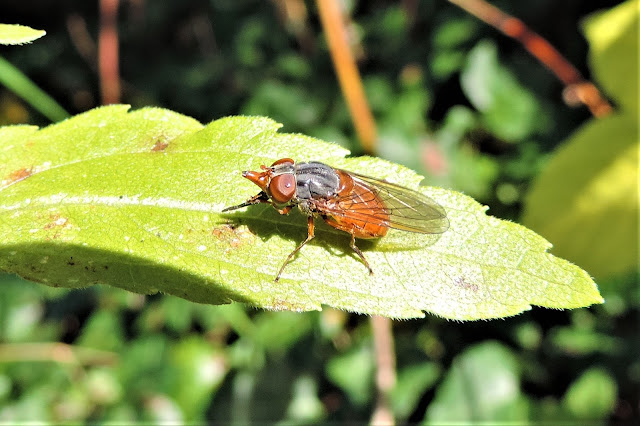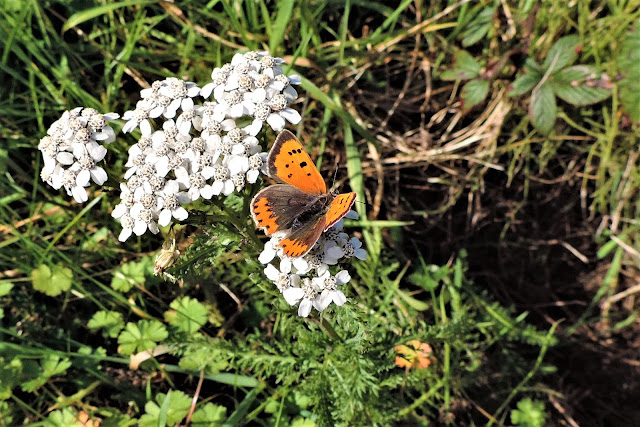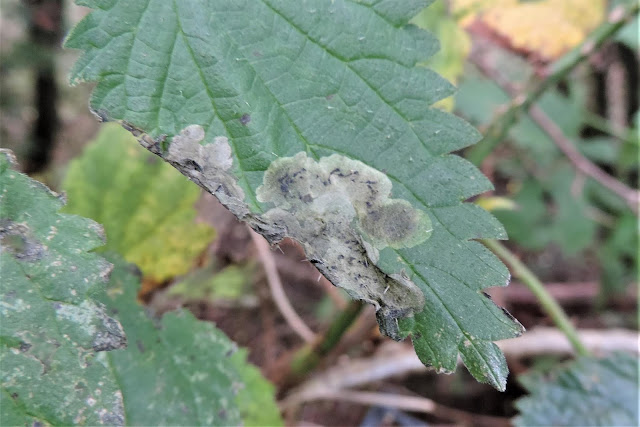Spent about half hour at 2 Ivy spots today, still quite a bit in bloom. We've had quite a few frosty nights this week but there still seems to be a few insects hanging on. 4 species of hoverfly still feeding on Ivy included Platycheirus albimanus (1), Episyrphus balteatus (9), Eristalis pertinax (5) and Eristalis tenax (13).
Other insects noted were Small Copper (1), Bronze Shieldbug (1), Harlequin Ladybird (2), Honey Bee (14), Common Carder Bee (3), Tree Wasp (15), Common Wasp (10) and Noon Fly (2) as well as about 50+ Bluebottle type flies. Had a few moth leaf-mine for a change. No birds of note except Ravens were constantly in the air and squabbling.
Eristalis pertinax
Platycheirus albimanus
Harlequin Ladybird - 4-red spot form
Phyllonorycter froelichiella - micro moth leaf-mine on Grey Alder
Stigmella plagicolella - micro moth leaf-mine on Blackthorn
Tuesday, 30 October 2018
Wednesday, 24 October 2018
Bits and Bobs last couple of days
After returning from Cornwall on Monday from ticking off the American Grey Catbird [my 400th British species], I have been visiting a few areas around the valley to see what's left and with the slim hope I might find something rare but to no avail. Today was warm for October and hit 17c by 1300hrs. But the next few days the weather is going to change due to stiff northerly winds and it has been forecast that on Saturday it will only be 5C during the day. Vapourer moths are now on the wing and I had 7 fly-bys today around Mynydd Bach. Surprisingly I also had three species of butterfly in Red Admiral, Small Copper and Speckled Wood. Hoverflies amounted to 11 flies of 6 species with the notably scarce Rhingia rostrata, my 4th of the year as the pick of the bunch. I continue to take photos of fly leaf-mines to fill the quiet periods and acquired another species. Again no Ring Ouzels at My. Bach, only 21 Meadow Pipits noted.
Rhingia rostrata - at Halfway House, Llangynwyd, the same place I had one last year on the 1st November.
Small Copper - on Yarrow at Waun-y-Gilfach Llangynwyd.
Speckled Wood - also at Waun-y-Gilfach
Common Shiny Woodlouse (Oniscus asellus) - My Bach top farm ruins.
Phytomyza cytisi - fly leaf-mine on Laburnum at Maesteg Cemetery entrance.
Hornet - there was an amazing 36 of this species feeding on Ivy and flying round Japanese Knotweed at the lane to Lletty Brongu sewage works. Up until this autumn I had only ever seen one before and that was at Bridgend Hospital 10 years ago. My total for this autumn is now over 50 and I have also recorded them at Maesteg Cemetery, Blaencaerau and Gilfach (west), Llangynwyd.
Rhingia rostrata - at Halfway House, Llangynwyd, the same place I had one last year on the 1st November.
Small Copper - on Yarrow at Waun-y-Gilfach Llangynwyd.
Speckled Wood - also at Waun-y-Gilfach
Common Shiny Woodlouse (Oniscus asellus) - My Bach top farm ruins.
Phytomyza cytisi - fly leaf-mine on Laburnum at Maesteg Cemetery entrance.
Hornet - there was an amazing 36 of this species feeding on Ivy and flying round Japanese Knotweed at the lane to Lletty Brongu sewage works. Up until this autumn I had only ever seen one before and that was at Bridgend Hospital 10 years ago. My total for this autumn is now over 50 and I have also recorded them at Maesteg Cemetery, Blaencaerau and Gilfach (west), Llangynwyd.
Thursday, 18 October 2018
Lletty and Llangynwyd Ivy
The hoverfly season is all but over until next March or April depending on how bad a winter we get, with Ivy now being about the only food source left for flies outside the urban ornamental gardens. So I had a look at the Ivy along the lane to the sewage works and the lane leading from Llangynwyd past the viaduct and up to the entrance to Cwm Darren Woods. I wasn't expecting much as although it was bright the areas with Ivy were in the shade and made photography almost impossible. As it was I managed to record a healthy 9 species for the time of year. The surprise was at Lletty Sewage Works lane where small patches of flowering Ivy had a few migrants in a single of Xanthandrus comtus (*), Scaeva pyrastri (*) and 2 Episyrphus balteatus, there was also a Eristalis pertinax present. At the viaduct lane there was much more Ivy in bloom and I recorded Melanostoma scalare (2)(*), Platycheirus albimanus (4), Platycheirus scutatus s.l. (1), Episyrphus balteatus (7), Meliscaeva cinctella (1)(*), Syrphus ribesii (2)(*) and Eristalis pertinax (6)(*). Six of these species were my latest dates for the year and are marked with an "*". I also had another Eristalis "similis" type, but without a photo for confirmation I'll just have to record as "Eristalis species" with a footnote explain why it could have been "similis". The X. comtus was probably my last new hoverfly for the year, giving me a total of 101 species + what's new in my specimens (2017 = 106 species).
Other insects were a little scarce although I did have another Hornet feeding on Ivy at Lletty Woods as well as 10-20 Common Wasps and a single Honey Bee. The only bird of note was a female Sparrowhawk.
Episyrphus balteatus - the dark orange colour instead of yellow would suggest this one hatched in UK rather than being a migrant.(darker colour in cooler conditions, brighter, yellow colour in warmer conditions)
Another fly leaf-mine, this time on Nettle - Agromyza pseudoreptans/reptans agg. (can only be distinguished by the differences in the larva, although pseudoreptans is the commoner/default species)
Other insects were a little scarce although I did have another Hornet feeding on Ivy at Lletty Woods as well as 10-20 Common Wasps and a single Honey Bee. The only bird of note was a female Sparrowhawk.
Episyrphus balteatus - the dark orange colour instead of yellow would suggest this one hatched in UK rather than being a migrant.(darker colour in cooler conditions, brighter, yellow colour in warmer conditions)
Another fly leaf-mine, this time on Nettle - Agromyza pseudoreptans/reptans agg. (can only be distinguished by the differences in the larva, although pseudoreptans is the commoner/default species)
Wednesday, 10 October 2018
My. Bach
A walk around My. Bach mid-levels in the warm sunshine (21c) looking for passage Ring Ouzel proved fruitless, with the best bird being a female Goshawk. I bumped into Colin Richards returning from the top plateau where he saw 6 Golden Plover and a female Merlin chasing pipits, which outshone my sightings.
Insect wise it looks like this will be one of the last recording days for the year. With numbers of species and overall individual numbers declining rapidly. I managed 7 species of hoverfly mainly on a few patches of Meadow Buttercup and Creeping Thistle. Eupeodes corollae (1) being the best and Episyrphus balteatus (6) the most numerous. 2 species of butterfly were seen - Speckled Wood and Comma. Plenty of Honey Bees and Common Carder Bee were seen lower down as were Common and Tree Wasp. Green Shieldbugs and Harlequin Ladybirds were also seen on various plants. Also seen on one of the mountain ponds were 2 late male Southern Hawker. And finally another new fly leaf-mine in Phytomyza ranunculi on Meadow Buttercup.
Eupeodes corollae
Harlequin Ladybird - four-spot form
Phytomyza ranunculi - fly leaf-mine on Meadow Buttercup, there are 2 similar species but neither of these has the frass grains close together forming short (black) lines in the mine as seen in the bottom of the photo.
Insect wise it looks like this will be one of the last recording days for the year. With numbers of species and overall individual numbers declining rapidly. I managed 7 species of hoverfly mainly on a few patches of Meadow Buttercup and Creeping Thistle. Eupeodes corollae (1) being the best and Episyrphus balteatus (6) the most numerous. 2 species of butterfly were seen - Speckled Wood and Comma. Plenty of Honey Bees and Common Carder Bee were seen lower down as were Common and Tree Wasp. Green Shieldbugs and Harlequin Ladybirds were also seen on various plants. Also seen on one of the mountain ponds were 2 late male Southern Hawker. And finally another new fly leaf-mine in Phytomyza ranunculi on Meadow Buttercup.
Eupeodes corollae
Harlequin Ladybird - four-spot form
Phytomyza ranunculi - fly leaf-mine on Meadow Buttercup, there are 2 similar species but neither of these has the frass grains close together forming short (black) lines in the mine as seen in the bottom of the photo.
Friday, 5 October 2018
Cemetery re-visited
The Ivy at the cemetery was again disappointing so I switched my attention to the small damp meadow outside the main entrance. As well as holding Devilsbit Scabious, Creeping Thistle and various yellow composites the surrounding trees included Black Poplar, Grey Alder and Large-leaved Lime. The area held 7 species of hoverfly with the best being Eupeodes corollae (1) and the most numerous being Melanostoma scalare (10).
Otherwise a Red Admiral was on the car park Buddleah Bush and another fly leaf-miner confirmed in Agromyza albitarsis on Black Poplar. A goshawk made a pass-over.
Cemetery meadow
Red Admiral
Eristalis tenax
Agromyza albitarsis fly leaf-miner on Black Poplar
Otherwise a Red Admiral was on the car park Buddleah Bush and another fly leaf-miner confirmed in Agromyza albitarsis on Black Poplar. A goshawk made a pass-over.
Cemetery meadow
Red Admiral
Eristalis tenax
Agromyza albitarsis fly leaf-miner on Black Poplar
Wednesday, 3 October 2018
Blaencaerau COP
The weather has been pretty grim today but we did have an hour break late afternoon. So I had a quick walk around the coal spoil area. I managed to find 6 species of hoverfly with a latish Helophilus pendulus the best and Melanostoma scalare the most numerous (8). Other insects included Green Shieldbug, 7-spot Ladybird and a day feeding Rosy Rustic moth. A flock of post breeding Goldfinch numbering 24 were the only birds to speak of.
Helophilus pendulus
Rosy Rustic - I think [can you confirm Sid ?]
Field Vole nest under a sheet of corrugated iron
Helophilus pendulus
Rosy Rustic - I think [can you confirm Sid ?]
Field Vole nest under a sheet of corrugated iron
Monday, 1 October 2018
Maesteg cemetery area
Hoverfly numbers have plummeted since the cold (near zero) night of the 24th September, in fact only two species seen today - Melanostoma scalare (6) and Episyrphus balteatus (3) neither of which was on ivy. The only insects on Ivy were 50+ Common Wasp and various Blow fly species. The Buddleah Bush didn't have the Eristalis similis I found a couple of days ago but held 3 Comma and 2 Speckled Wood Butterfly. Also present was a Hummingbird Hawkmoth, my 3rd of the year and the nearby shrubbery held a few Green Shieldbug, Harlequin Ladybird and Yellow Dung Fly and as they say "that was it".
Episyrphus balteatus
Comma
Episyrphus balteatus
Comma
Subscribe to:
Comments (Atom)
























